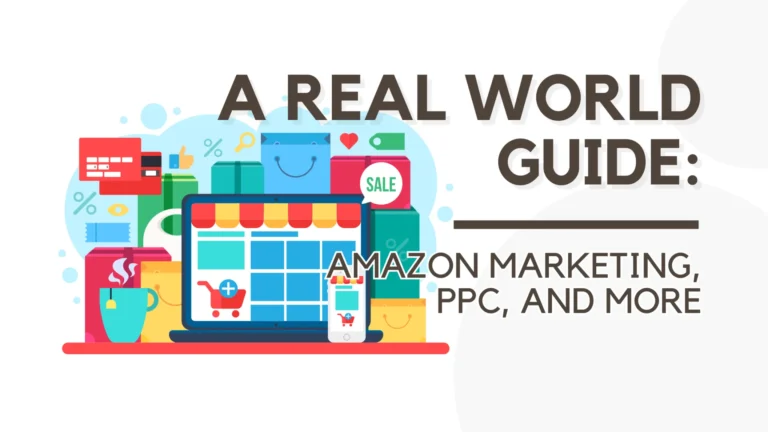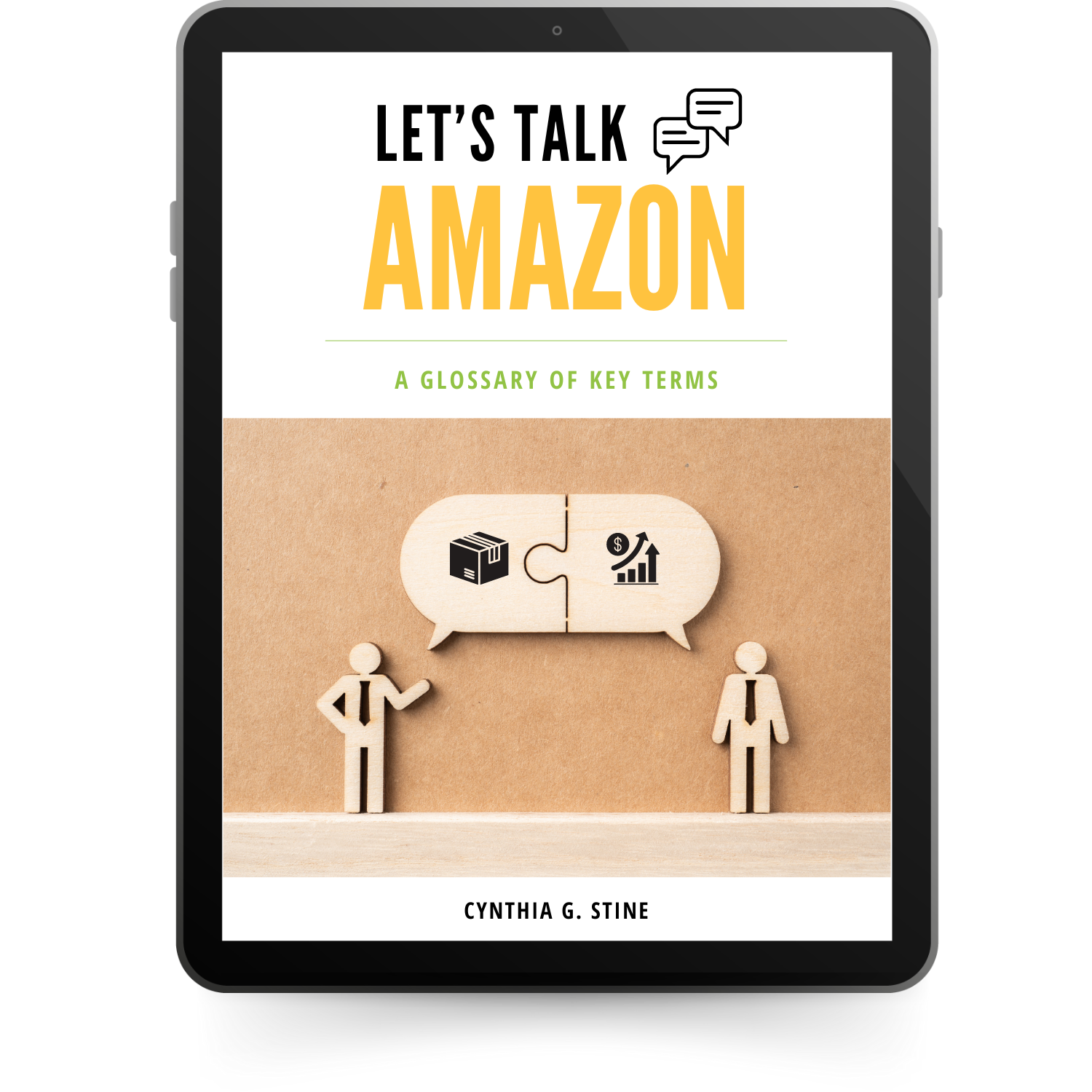This blog post originally appeared on Azama Brands and was written by Emily Murray. We work closely with Azama Brands, or one of her affiliated companies, on behalf of our clients and thought you might find this recent post interesting.
Since 1994, Amazon.com has been instrumental in building the online world we live in today, setting new benchmarks for ecommerce, and optimizing the marketplace business model on the fly.
The rising sales numbers tell the story — in 2023 alone, Amazon achieved almost $575 billion in net sales revenue globally. With its extensive reach and influence, Amazon is now recognized as one of the most valuable brands the world over. (1) With these kinds of numbers, it only makes sense to advertise your brand here too.
Thanks to our collective Amazon experience on the Azama Brands team, we’re well-positioned to help brands make significant gains toward their goals… because we know Amazon’s marketing programs like no one else, and because we always start with the customer first and work backwards from there. We learn everything there is to know about a particular audience, so we know exactly how to create marketing that speaks to them. Then we work directly with the advertising expert of our client’s choice, to align the brand’s content and its advertising with its business objectives.
A Real World Example
Take for instance FilterBaby, a faucet mounted water filtration brand. They came to Azama Brands for help in building an Amazon.com presence, and these were our results after just a few short months:
- 200k in sales over their first holiday season.
- Conversion rates jumped from 2.06% to 3.68% on one color, and 2.94% to 5.47% on the other after upgrading to Premium A+.
- ROAS (return on ad spend) went from 1.64 to 2.96 with no other change than Premium A+.
There were a lot of moving parts, of course, but the bottom line is we did this by listening to the customer. Then we created content that answers their questions, like a friend would, and then we got that content in front of them.
As Rachel Johnson Greer, founder of Azama says: “When people feel heard and understood, they are empowered to make choices, and when your brand is the one doing the empowering, the choice is clear.”
This real world guide offers information on Amazon’s suite of marketing programs… the pros, cons, and who they’re best for… plus insider tips on how Azama Brands helps our clients focus on and leverage the areas that can mean the most for their brand.
Amazon Ad Solutions
Amazon offers various marketing programs to help brands of all sizes increase visibility and drive sales.
Programs like Sponsored Products, Sponsored Brands, Sponsored Display, and Amazon DSP (Demand Side Platform) are all available with no advertising experience needed to get them up and running.
Understanding each one, how it can benefit your brand (or not), and utilizing PPC (Pay-Per-Click) campaigns is crucial for strategic positioning, controlling advertising costs, and maximizing return on investment.
Creating the kind of content that speaks right to your target audience is the second big piece to the puzzle. If the content doesn’t woo them, it doesn’t matter if it reaches them or not.
Overview Of Amazon’s Marketing Programs
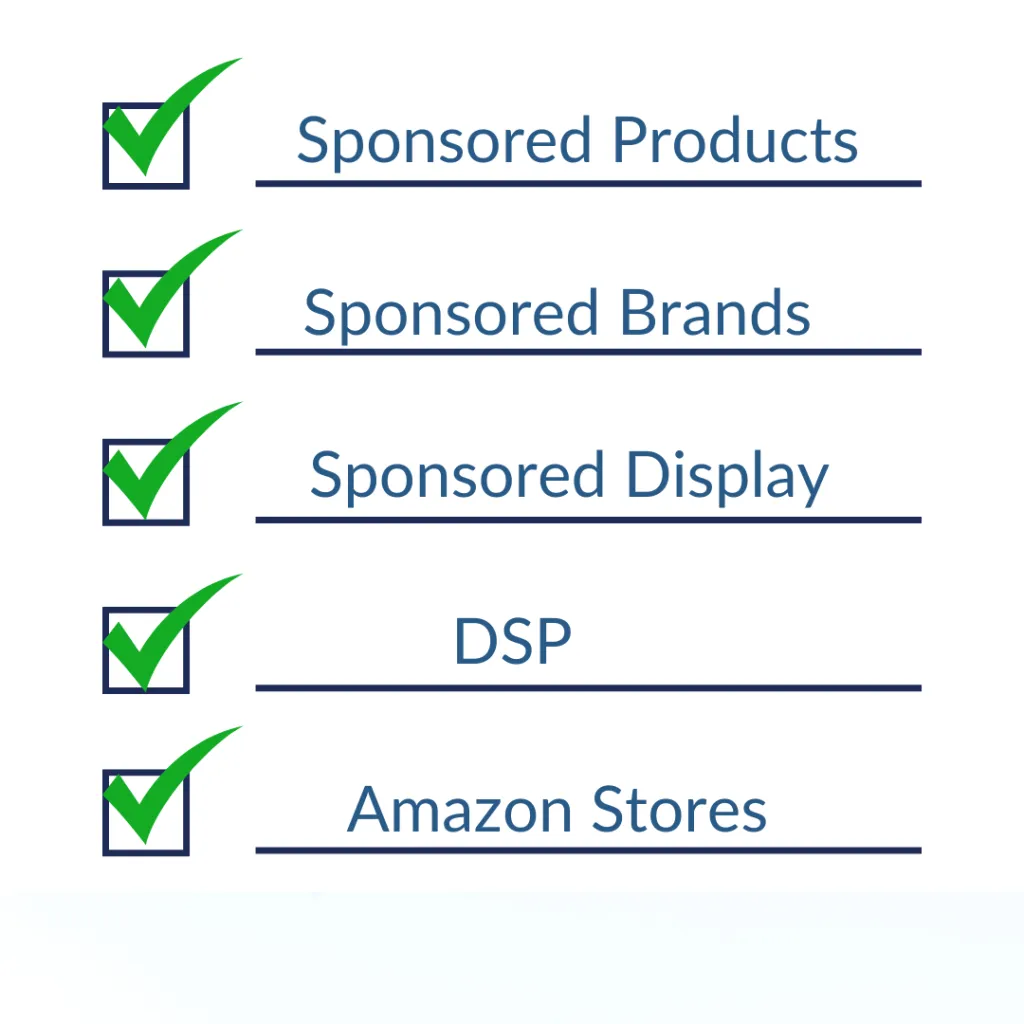
Sponsored Products allows sellers to promote individual product listings within search results and product detail pages. It’s also one of the most common starting points for brands on Amazon. Sponsored Products ads appear prominently alongside organic search results, increasing the likelihood of potential customers seeing and clicking on the advertised products.
Key features of Sponsored Products:
- Keyword targeting: Choose specific keywords that shoppers are likely to use when searching for products similar to yours.
- Product placement: Ads can appear in high-visibility locations, such as the top of search results or on product detail pages.
- Bidding strategies: Set manual bids or use Amazon’s automated bidding options, like dynamic bidding, which adjusts bids in real-time based on the likelihood of a sale.
Sponsored Brands is designed to enhance brand visibility, with customizable ads featuring a brand’s logo, a personalized headline, and a selection of products. These ads appear prominently at the top of search results, giving brands a prime opportunity to capture potential customers’ attention.
With an Amazon Sponsored Brands ad there are different formats: product collection, Store Spotlight, and video placements. When using product collection and Store Spotlight, you can customize the headline to showcase your brand’s USP and show examples of your product selection. (2)
When using video placements, you can use both horizontal and vertical video displays to garner attention and engagement from Amazon shoppers.
Key features of Sponsored Brands:
- Custom headline creation
- Logo display
- Directing traffic to a brand store or customized landing page
Sponsored Brands is available only to vendors and professional sellers enrolled in the Amazon Brand Registry, so it’s particularly beneficial for established brands that are focused on building and enhancing their presence on Amazon.
Sponsored Display ads are a versatile solution that allows sellers to reach potential customers both on and off the Amazon platform. These ads target shoppers based on their browsing behavior, purchase history, and interests, making them highly effective in re-engaging audiences and driving brand awareness.
Key features of Sponsored Display Ads:
- Audience targeting
- Product display
- Remarketing opportunities
Sponsored Display Ads are available only to Amazon vendors and sellers who are registered brand owners. This program is best suited to brands aiming to reach audiences beyond Amazon and target potential customers at various stages of their buying journey.
Amazon DSP (Demand Side Platform)
Amazon DSP is a sophisticated advertising tool that enables sellers and brands to purchase programmatic ads across Amazon’s network and beyond. It uses automated technology to bid on ad inventory in real-time, allowing advertisers to efficiently reach targeted audiences with precision.
Key features of Amazon DSP:
- Use of first-party data
- Cross-channel campaigns
- Custom audience targeting
Amazon DSP is perfect for advanced sellers with larger budgets aiming for wide, comprehensive reach. Its programmatic ad buying capabilities allow for precise audience targeting across a wide array of channels. Amazon DSP and Amazon Marketing Cloud are both available to advertisers whether they sell on Amazon or not.
An Amazon Store provides a centralized, customizable hub where brands can showcase their entire product line. Plus, it’s free. This dedicated space allows brands to tell their story, highlight key products, and provide a cohesive shopping experience for customers. An Amazon Store is like a brand’s own website on Amazon.com, and can increase sales dramatically. What’s more, search engines can index them, making them able to appear in SERPs (search engine results pages).
Key features of Amazon Stores:
- Total Customization
- Multimedia content
- Traffic-driving strategies
Amazon Stores is perfect for brands of all sizes looking to create a branded shopping experience. They provide a dedicated space to showcase brand identity, tell a story, and offer a curated selection of products in a visually cohesive manner. With a drag and drop interface, it’s easy to use even for a novice, and with its strong impact on sales and brand presence, at Azama Brands we recommend a Store for all clients in the Brand Registry.
Stores is special among Amazon’s online advertising solutions for a couple of reasons.
First, unlike a detail page, a Store can (and should) have multiple landing pages. Depending on a visitor’s search term, they can be offered the same product on multiple different pages. For one Azama client, the Store has over a hundred pages, with lots of overlap between the products that appear on each of these pages.
Shoppers come looking for a common solution, but they may search for it in a different way. With a Store, you can capture all the people who are looking for your product but using different words for it. For example, soda, pop, soda pop, a soft drink, and even simply “Coke” in some parts of the US, is a word to describe that fizzy fountain drink that goes great with a burger and fries. It just depends on how and where you were raised, what word you search with. But if you’re selling a fizzy fountain drink, you want all that traffic coming your way, and to appeal to all those searchers. With Stores you can make each term its very own page, and tailor everything on it to the kind of person who would use that word to search.
Where advertising and content meet, Stores is there. It’s the fulcrum point between the two worlds, and it’s a must for any brand that’s serious about business on Amazon. And again, it’s free! All it costs is time.
Amazon PPC: A Deep Dive
Amazon PPC is a powerful advertising tool for brands, allowing you to display sponsored product listings in search results and on product detail pages, and paying only when a shopper clicks on the ad.
For growing brands, the strategic use of PPC campaigns can significantly boost visibility and sales. They help new products gain traction by appearing alongside established competitors in search results. This increased exposure can lead to more sales, reviews, and improved organic ranking over time.
For brands looking to sustain growth, PPC campaigns help maintain market position and defend against competitors. They can be used to target specific keywords, cross-sell related products, and retarget previous customers. Advanced features like automatic targeting and dayparting allow for optimization of ad spend and ROI.
Growing and established brands alike can benefit from the data insights provided by PPC campaigns. At Azama Brands not only do we believe strongly in the power of in-depth customer analysis and content to match it, but we rely heavily on metrics to inform inventory management, pricing strategies, and product development decisions for our clients. This contributes to their long-term success both on the Amazon platform and beyond.
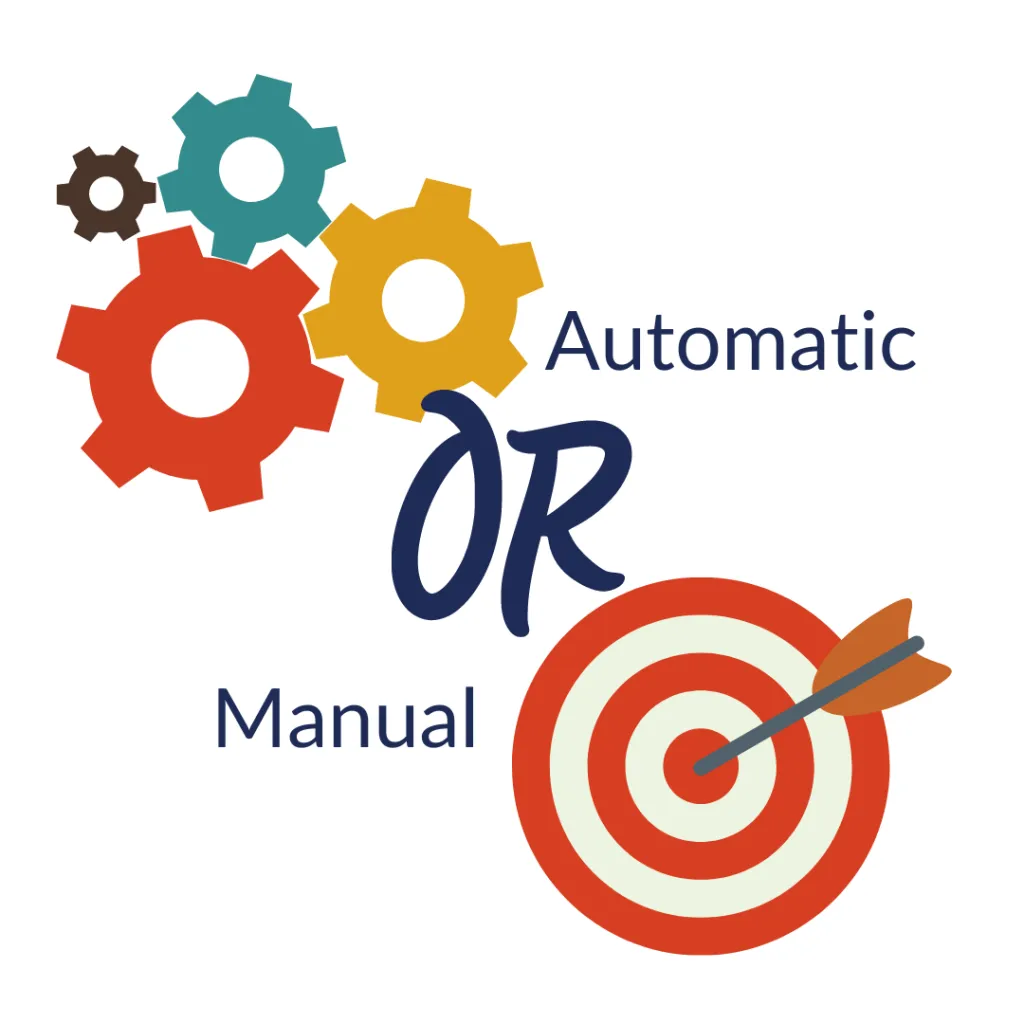
The 2 PPC Campaign Types
1. Automatic Campaigns
Amazon’s algorithm automatically selects relevant keywords and matches ads to customer search terms and products.
- Benefits: Simplicity, no need for extensive keyword research.
- Best for: Beginners or quick setup with minimal effort.
- Drawback: Less control over targeting.
2. Manual Campaigns
Advertisers choose specific keywords and set individual bids.
- Benefits: Greater control, ability to target high-performing keywords and optimize bids.
- Best for: Advertisers with clear understanding of target keywords.
- Drawback: Requires more time and expertise to manage effectively.
The 3 PPC Keyword Targeting Types
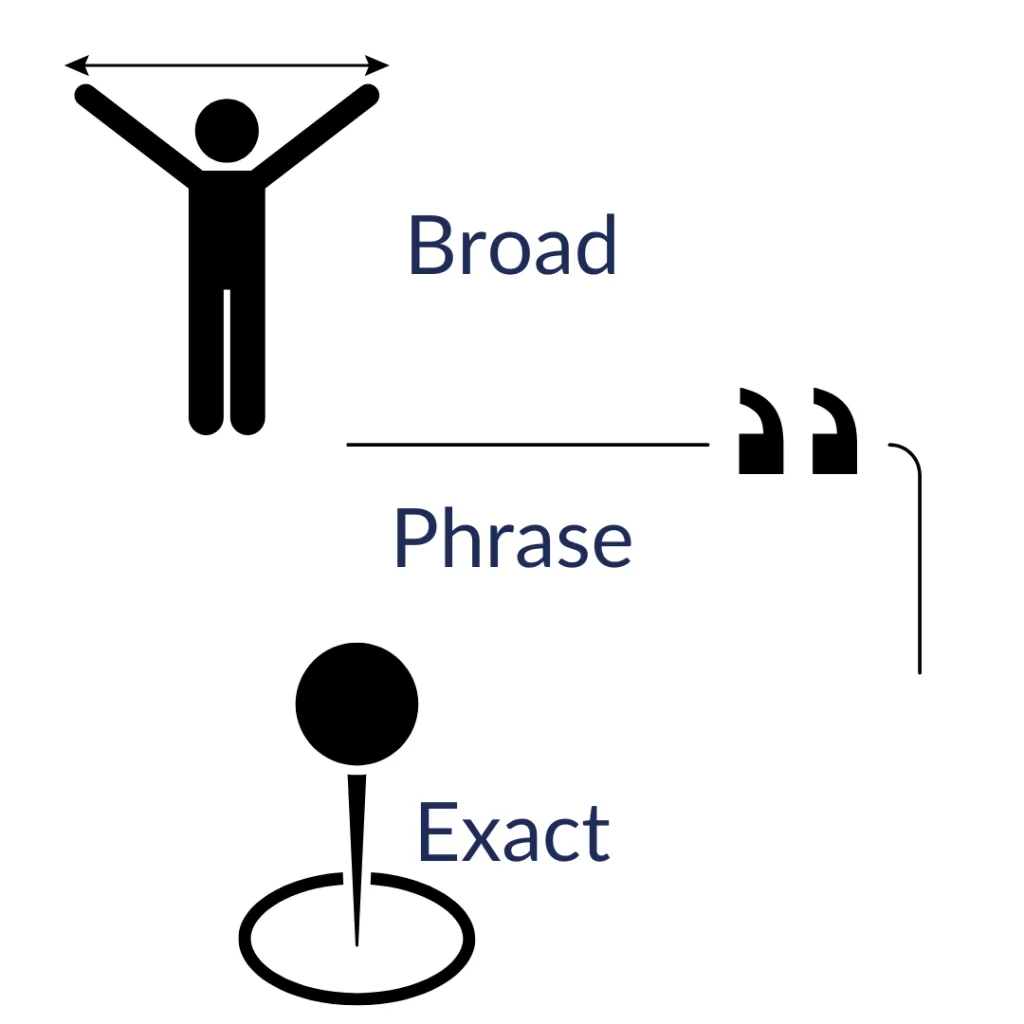
1. Broad Match
The most flexible option, allowing ads to show for a wide variety of search terms.
- Pro: Wide audience reach.
- Con: Can lead to less relevant clicks.
2. Phrase Match
Ads show when the search term contains the exact sequence of words in the keyword.
- Pro: Balances reach with relevance.
- Con: Less flexible than broad match.
3. Exact Match
Highest level of precision, ads appear only for exact keyword matches or close variants.
- Pro: Higher conversion rates.
- Con: Narrower reach.
PPC Product Targeting
Product Attribute Targeting (PAT) allows sellers to target specific products or categories instead of relying solely on keywords. This strategy is effective for reaching shoppers interested in similar or complementary products, increasing the chances of conversion.
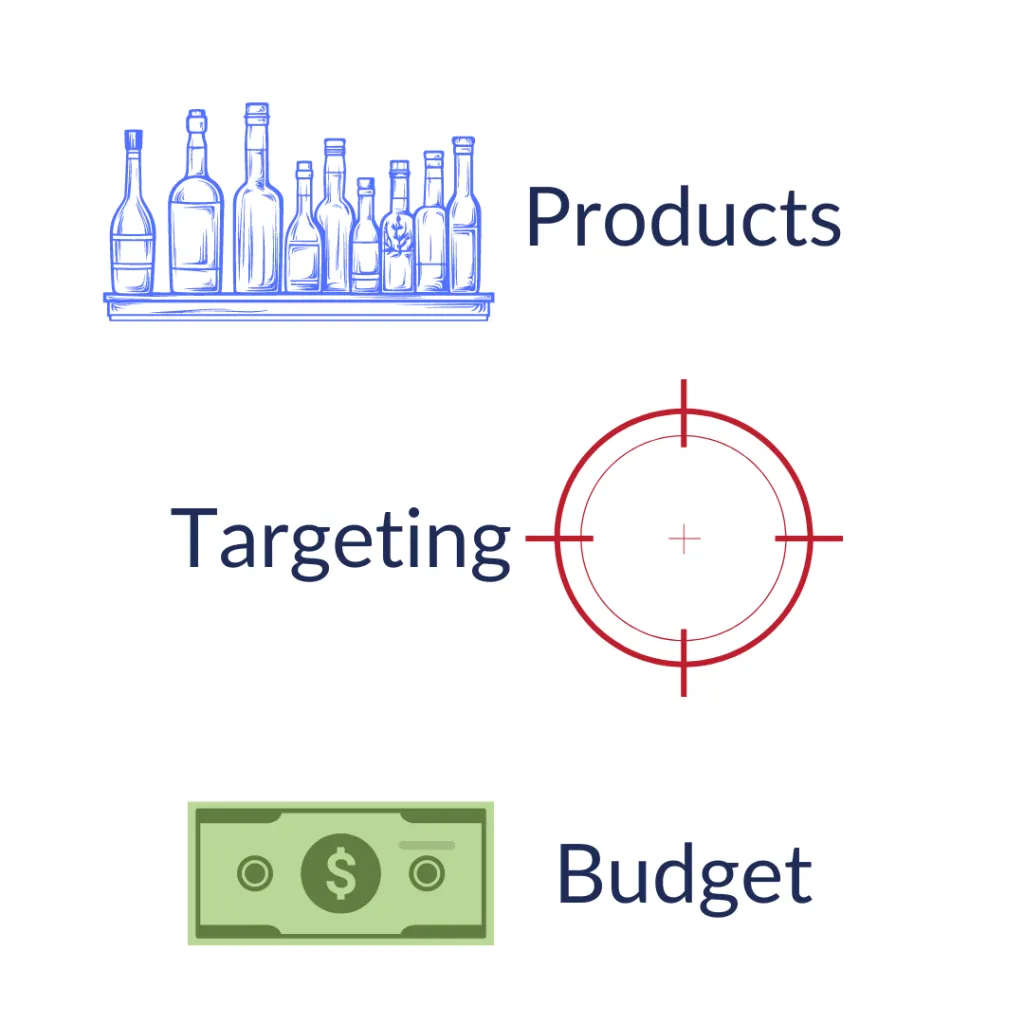
Setting Up A PPC Campaign – A Step-By-Step Guide
How To Create An Amazon PPC Campaign In 3 Steps
1. Select Products
- Choose items with strong sales potential, competitive pricing, and high-quality images/descriptions.
- Products with positive reviews and good conversion rates are ideal candidates.
2. Choose Targeting Options
- Decide between keyword targeting or Product Attribute Targeting (PAT).
- For keyword targeting, choose between automatic and manual campaigns.
- For PAT, target specific products or categories.
3. Set The Budget
- Determine a daily budget aligned with overall advertising goals and product margins.
- Set bids for keywords or PAT targets.
- Consider starting with conservative bids and adjusting based on performance data.
Top 3 Amazon PPC Best Practices
1. Start with a clear objective
- Define goals (e.g., increase sales, boost brand awareness, drive traffic).
- Use objectives to guide strategy and measure success.
2. Set realistic bids
- Research average cost-per-click (CPC) for chosen keywords or target products.
- Balance competitiveness and cost-efficiency.
- Regularly monitor and adjust bids based on performance data.
3. Use negative keywords
- Prevent ads from showing for irrelevant search terms.
- Regularly update negative keyword lists based on search term reports. targeting, ensuring your ads reach the right audience and improve overall campaign efficiency.
PPC Budget Management
5 Steps To Setting The Right PPC Budget
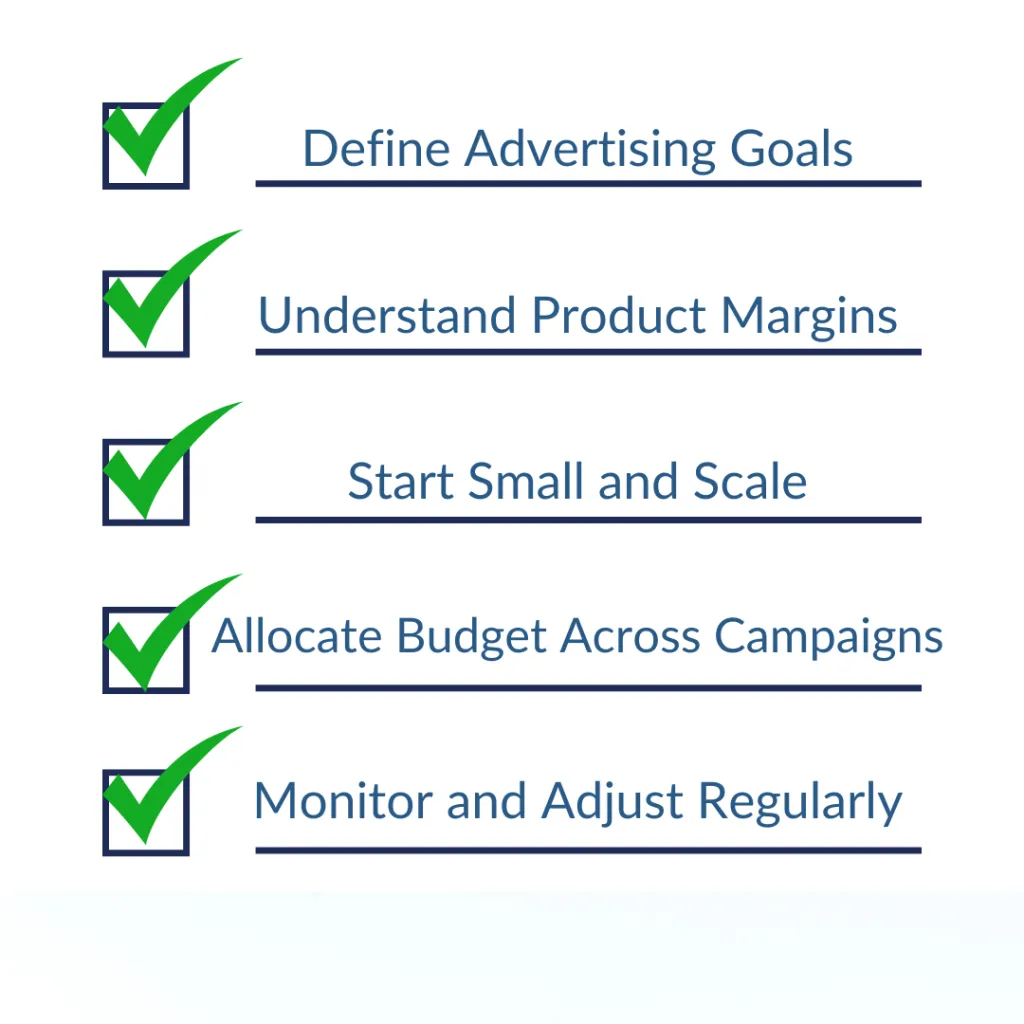
Allocating an Amazon PPC budget requires a careful balance between your advertising goals and product margins. Here are 5 simple guidelines to help you make informed decisions:
1. Define Advertising Goals
- Clarify objectives (e.g., brand visibility, sales, new product launch).
- Allocate budget based on goals.
2. Understand Product Margins
- Keep Advertising Cost of Sales (ACoS) below profit margin.
3. Start Small and Scale
- Begin with a conservative budget.
- Monitor performance metrics and increase budget for successful campaigns.
4. Allocate Budget Across Campaigns
- Distribute budget based on campaign types and goals.
5. Monitor and Adjust Regularly
- Review campaign performance and adjust budget allocation as needed.
Daily vs. Lifetime PPC Budgets
When setting up a PPC campaign on Amazon, you have the option to choose between Daily and Lifetime budgets. Each approach has its own advantages and disadvantages:
Daily Budget
- Pros: Consistent control, flexibility.
- Cons: Potential underutilization, requires regular monitoring.
Lifetime Budget
- Pros: Optimized spending, less maintenance.
- Cons: Less day-to-day control, risk of early exhaustion.
PPC Bid Adjustments
Adjusting bids in your PPC campaigns based on performance and competition is crucial for optimizing your ad spend and maximizing ROI. Here are a couple of effective strategies:
Performance-Based Adjustments
- Use metrics like ACoS, CTR, and conversion rate to guide bid adjustments.
- Increase bids for high-performing keywords/targets, decrease for underperforming ones.
Competitive Bidding Strategies
- Monitor competition and adjust bids accordingly.
- Use dynamic bidding options or third-party tools for insights.
- Balance competitiveness with profitability.
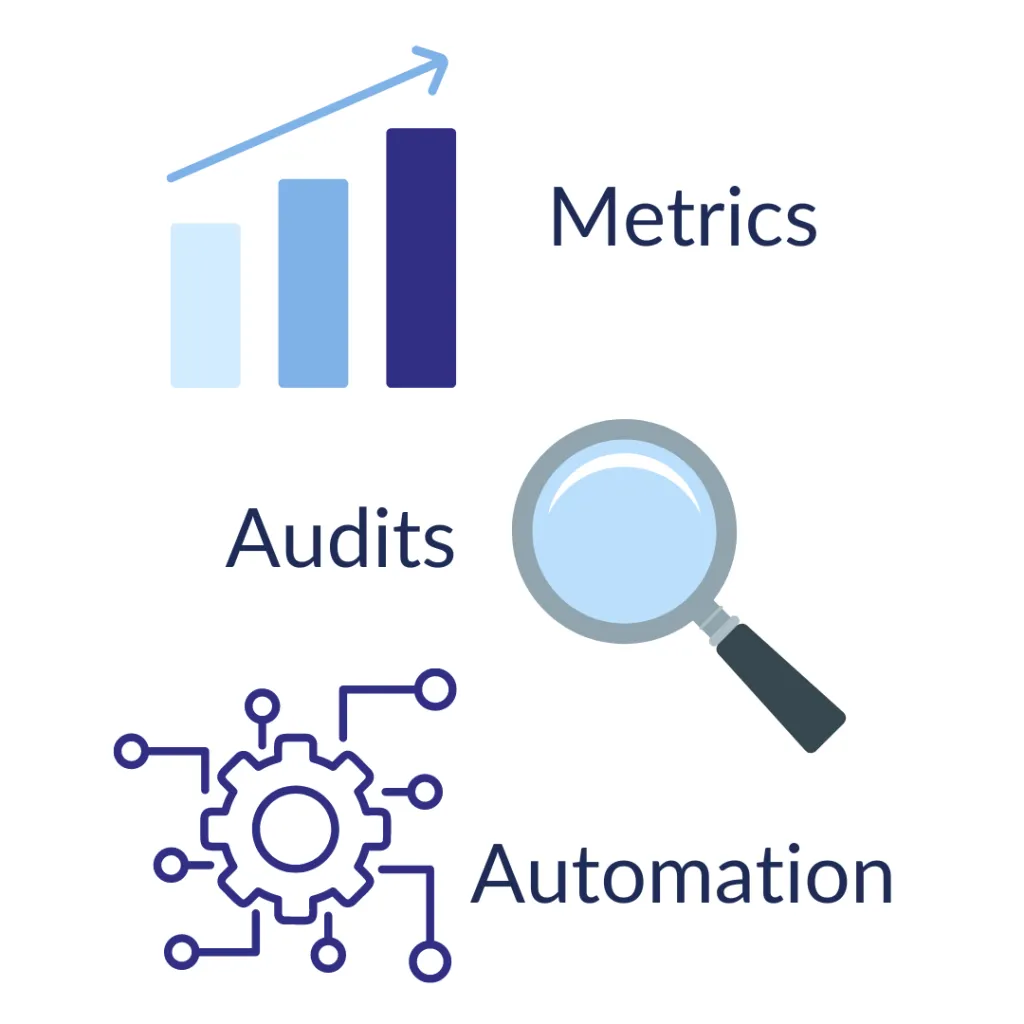
Amazon PPC Campaigns: Monitoring and Optimization
PPC Performance Metrics
ACoS (Advertising Cost of Sales)
- Indicates cost-effectiveness of campaigns.
- Lower ACoS typically means higher profitability.
CTR (Click-Through Rate)
- Measures ad relevance and appeal to target audience.
- High CTR suggests effective ad copy and targeting.
Conversion Rate
- Measures how effectively ads and product pages turn visitors into customers.
- High conversion rate indicates well-aligned product listings and offers.
Regular PPC Audits
Conduct regular audits to:
- Identify underperforming keywords, ads, or product targets.
- Reveal areas of budget waste.
- Adapt to market changes and consumer behavior.
- Continuously improve return on investment.
PPC Optimization Through A/B Testing
Use A/B testing to:
- Compare different versions of ads.
- Experiment with various elements (e.g., ad creatives, keywords, targeting options).
- Identify what resonates most with the audience.
- Continually improve campaign effectiveness.
Scaling Your PPC Campaigns

Consider Scaling When
- Current campaigns consistently deliver strong results.
- Seasonal trends or product launches create opportunities.
- Market conditions or competitor activity signal a need for increased efforts.
- You have a clear understanding of high-performing keywords and audiences.
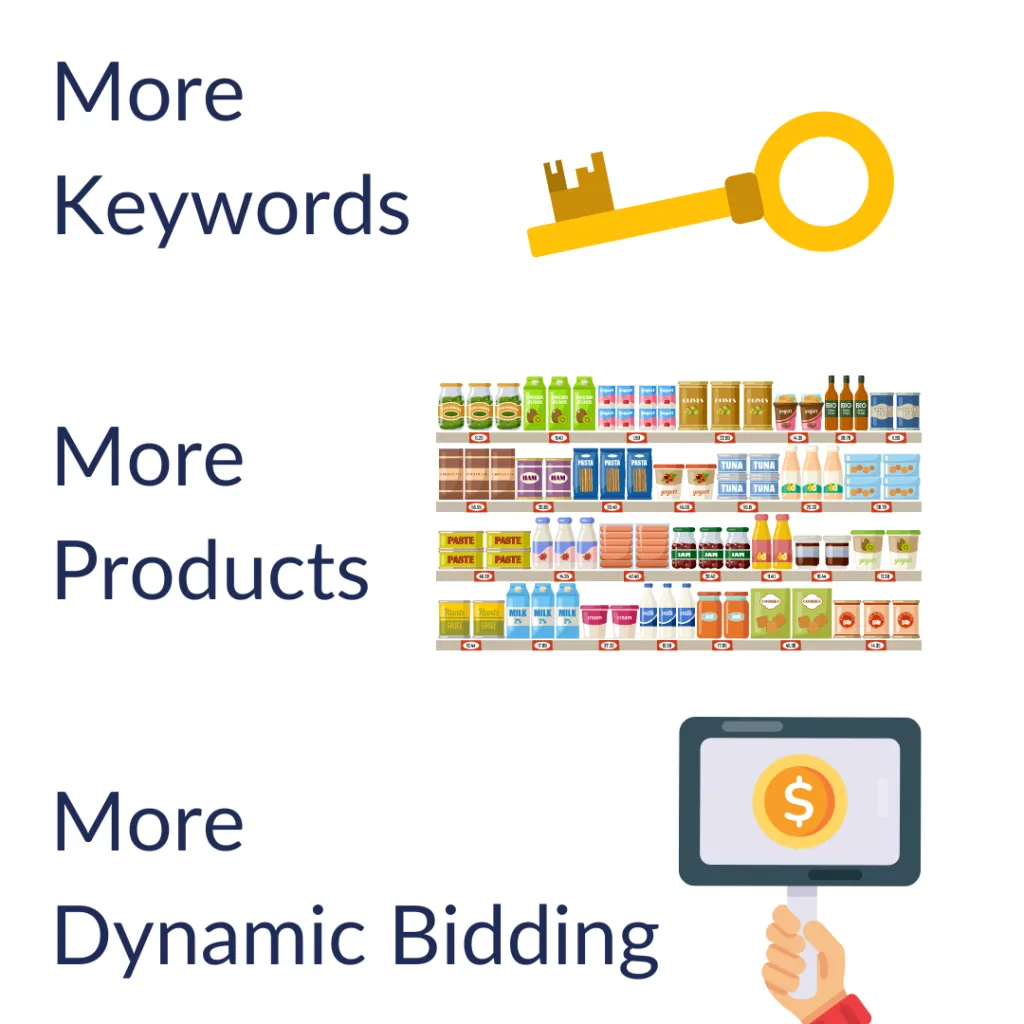
Top 3 PPC Scaling Strategies
Scaling your PPC campaigns effectively involves several strategic methods to broaden your reach and optimize performance. With methods like expanding keywords, targeting more products, and leveraging dynamic bidding, you can effectively scale your PPC campaigns, increase your reach, and drive greater returns on your advertising investment.
1. Expanding Keywords
- Identify high-performing keywords and explore related terms.
- Use Amazon’s keyword research or third-party tools to discover new opportunities.
2. Targeting More Products
- Extend PPC efforts to complementary or similar items.
- Ensure each product has optimized listings.
3. Using Amazon’s Dynamic Bidding Options
- Leverage automated bid adjustments based on conversion likelihood.
- Optimize ad spend by allocating budget to high-impact areas.
Thorough market and keyword research can not be overlooked at any point in the brand building process, and PPC advertising is just one example of an area where it can be extremely useful. For FilterBaby, in the initial stages of researching and strategizing how to jump-start their Amazon sales, we noticed that they already had search traffic on Amazon. People had been searching for FilterBaby, but FilterBaby wasn’t there to be found. When we started bidding for the keywords that people were already searching for, great things started happening. Like that 200k in sales that first holiday season. Read the whole story here.
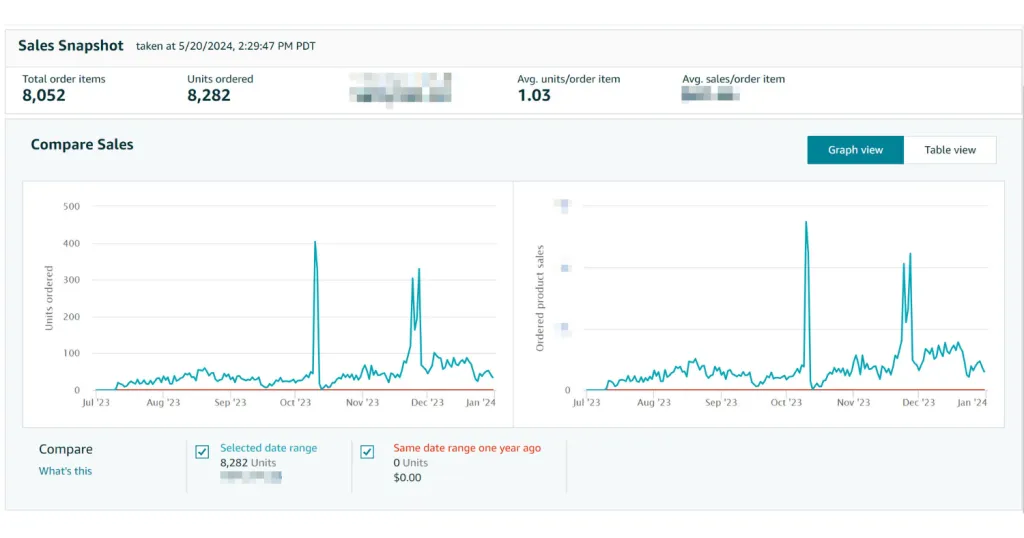
The blue line represents sales in 2023, the red (flat) line is the same time period in 2022
Content That Converts
One key aspect many brands overlook is how a piece of content’s composition affects its appeal to specific customers. Every element, from the race or gender of an individual featured in the content to their age, physical ability, or clothing choices, subtly influences people’s perceptions of a brand or product and its benefits. This is simply human nature.
To target the right audience, create content that resonates with the customer segments who use particular search terms. Consider again the “soda” and “pop” example from before. By focusing on specific keywords, you’re actually targeting a certain type of person. Your content should mirror the reader’s self-perception and understanding.
When someone searches for “pop,” they should encounter content tailored for a “pop kind of person” – whatever that may entail (detailed research will reveal the specifics). Similarly, those searching for “soda” should find content crafted for the “soda” folks.
At Azama Brands we align the content strategy with the advertising strategy, ensuring that soda searchers receive soda-oriented content, while pop searchers find pop-centric stuff. This targeted alignment is the cornerstone of our unique approach.
Top 3 PPC Pitfalls and How to Avoid Them
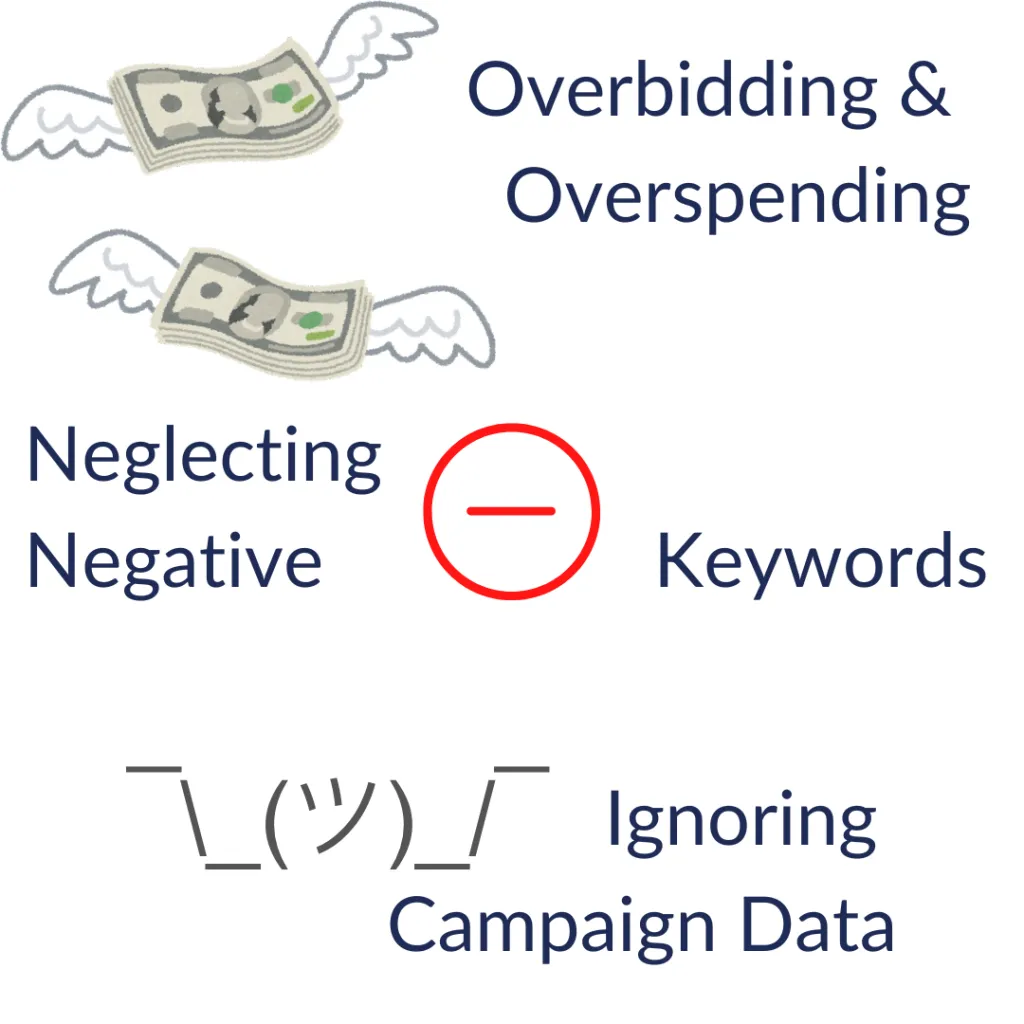
1. Overbidding and Overspending
Aggressively bidding on high-traffic keywords without considering relevance or intent.
How to Avoid:
- Set realistic bids based on careful keyword research.
- Focus on highly relevant terms likely to convert.
- Regularly review and adjust bids based on performance metrics.
2. Neglecting Negative Keywords
Allowing ads to appear for irrelevant search terms, wasting budget on low-intent clicks.
How to Avoid:
- Regularly review search term reports to identify irrelevant queries.
- Add irrelevant terms to the negative keyword list.
- Use broad or phrase match types cautiously.
3. Ignoring Campaign Data
Missing critical insights into campaign performance, leading to wasted budget and poor ROI.
How to Avoid:
- Make data analysis a regular part of campaign management.
- Review key metrics weekly or bi-weekly.
- Use data to make informed decisions on budget allocation, bid adjustments, and keyword optimization.
- Implement automated reports and alerts to stay on top of performance trends.
Amazon’s Marketing Ecosystem Is Your Path to E-Commerce Success
Amazon’s suite of advertising solutions offers powerful tools for all kinds of brands to increase visibility, drive sales, and build lasting customer relationships.
From Sponsored Products and Sponsored Brands to Amazon Stores and sophisticated PPC campaigns, each program provides unique opportunities to connect with potential customers at various stages of their buying journey. Success on Amazon (and beyond) requires a strategic approach, complete with thorough market research, targeted content creation, and continuous optimization of advertising efforts.
By leveraging these tools effectively, brands can not only boost their immediate sales but also gain valuable insights into customer behavior and preferences. This data-driven approach allows for smarter inventory management, pricing strategies, and product development decisions, contributing to long-term success both on and off the Amazon platform.
At Azama we’ve proven that the key to maximizing ROI lies in 3 important areas:
- Understanding your audience
- Compelling content that resonates with specific customer segments
- Continually refining ad strategies based on performance data
Whether you’re a growing brand looking to make your mark or an established player aiming to maintain your market position, Amazon’s marketing programs offer the flexibility and power to achieve your goals in the ever-evolving world of e-commerce… and Azama is here to help make it happen. What can we do for you?

